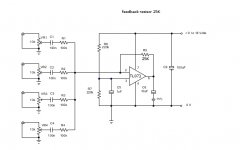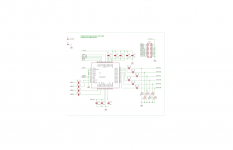I am building some four channel virtual earth mixer, this normally uses 10k pot`s.
I have the opportunity to purchase some 50k pot`s cheaply.
My question is do you think that using the 50k pot`s will be satisfactory for this circuit and sound quality?
I have the opportunity to purchase some 50k pot`s cheaply.
My question is do you think that using the 50k pot`s will be satisfactory for this circuit and sound quality?
Attachments
The 50k pots will do for casual use, but 10k pots will work better in a number of ways.
Capacitor C6 should not be used on the output of the op amp.
Capacitor C6 should not be used on the output of the op amp.
There must be no problem. Take into account pot loading by the 100KΩ resistors, what will modify the pot curve. I suggest to increase them to 500KΩ, and in the same way, the feedback resistor. But no way to cause major problems.
Thank you for your replys.
Rayma you say the "10k pots will work better in a number of ways", What ways?
Osvaldo you think that 50k pots are no problem
By the way, I notice I posted an old circuit diagram, I have since increased feedback resistor to 100K for unity gain.
Rayma you say the "10k pots will work better in a number of ways", What ways?
Osvaldo you think that 50k pots are no problem
By the way, I notice I posted an old circuit diagram, I have since increased feedback resistor to 100K for unity gain.
you say the "10k pots will work better in a number of ways", What ways?
Lower impedance gives lower noise and better HF response. But if this is for casual musical instrument use, these things are not so important.
Last edited:
Smaller resistance implies directly lower noise, but higher load to the previous stage(s) or source(s). In other way, 50KΩ is a standard input value. Go on!
The capacitors should be before the pots, not after, so they see a constant load impedance and keep fixed frequency response. With your 50k pots 220nF would be equivalent to that diagram, but 1µF would be preferred for LF response.
50k is going to cause noise issues though, and increasing the 100k's to 500k is _really_ going to make noise apparent. Keep the 100k's at 100k, the 50k pots source impedance is at worst 12.5k and thus 100k isn't loading them too much.
Buffering the pots before driving the summing bus would be preferred, as much smaller resistors can be used and the summing bus will be lower noise and less likely to pick up crosstalk.
The full-on ideal approach is active volume controls, driving a low impedance summing bus.
I also note that circuit assumes the output should never clip until all 4 inputs are themselves clipping - so when only using 1 input the output cannot be more than 25% of the max output.
Not sure you ever want that amount of attenuation in a mixer - best to arrange that one input fully driven drives the output fully, ie the input and output levels are the same (with volume pot at max).
50k is going to cause noise issues though, and increasing the 100k's to 500k is _really_ going to make noise apparent. Keep the 100k's at 100k, the 50k pots source impedance is at worst 12.5k and thus 100k isn't loading them too much.
Buffering the pots before driving the summing bus would be preferred, as much smaller resistors can be used and the summing bus will be lower noise and less likely to pick up crosstalk.
The full-on ideal approach is active volume controls, driving a low impedance summing bus.
I also note that circuit assumes the output should never clip until all 4 inputs are themselves clipping - so when only using 1 input the output cannot be more than 25% of the max output.
Not sure you ever want that amount of attenuation in a mixer - best to arrange that one input fully driven drives the output fully, ie the input and output levels are the same (with volume pot at max).
The op amp is running single ended and so has 1/2 V+ on the output. C6 blocks that DC and lets only signal through.
Capacitors on the input to mixer
I am using this Mixer to mix four outputs from a wav file players DAC. (See attached schematic).
It has been suggested by Mark Tillotson that the capacitors should be before the potentiometers.
Given that the DAC board has onboard capacitors on the outputs; would it be ok to leave out those capacitors from my mixer circuit?
I am using this Mixer to mix four outputs from a wav file players DAC. (See attached schematic).
It has been suggested by Mark Tillotson that the capacitors should be before the potentiometers.
Given that the DAC board has onboard capacitors on the outputs; would it be ok to leave out those capacitors from my mixer circuit?
Attachments
A 50k pot feeding a 100k load will not have its volume law altered by very much. Most of the thermal noise will come from the 100k resistor, as it does with a 10k pot.
You need a cap after the pot because the opamp input is DC elevated.Mark Tillotson said:The capacitors should be before the pots, not after, so they see a constant load impedance and keep fixed frequency response.
- but if they are in parallel, then total "termal noise" resistance will be 50k||100k= 33,3k.. Most of the thermal noise will come from the 100k resistor, as it does with a 10k pot.
?!
But they are not in parallel, they are in series. Assuming a low impedance source, the maximum output impedance from a 50k pot will be 12.5k. The total series resistance is thus 112.5k. With a 10k pot it will be 102.5k, so you get 0.4dB less noise - not worth worrying about.
The op amp is running single ended and so has 1/2 V+ on the output. C6 blocks that DC and lets only signal through.
Ah yes, didn't notice that.
But they are not in parallel, they are in series. Assuming a low impedance source, the maximum output impedance from a 50k pot will be 12.5k. The total series resistance is thus 112.5k. With a 10k pot it will be 102.5k, so you get 0.4dB less noise - not worth worrying about.
But with 10k pots you can change the 100k's down to a much lower value, with a big effect on noise.
Note that the opamp is JFET and this is vital to avoid having current noise issues - use a random bipolar opamp with 100k source resistance and you'll likely get 40--200 nV/sqrt(Hz) noise or more from the current-noise multiplied by source impedance.
Get the impedances down to 10k or less and the opamp can be bipolar and benefit from lower voltage noise.
But with 10k pots you can change the 100k's down to a much lower value, with a big effect on noise.
Ok If I use the 10K pots I can make the 100k resistors to a much lower value and by how much?
If I go for the 50K pots would it also be ok and beneficial, to reduce the 100K resistors to a lower value and by how much?
Use linear 10k pots, with input resistors 10k, and feedback resistor 100k.
This will give up to +20dB gain.
This will give up to +20dB gain.
The existing circuit has -12dB 'gain'. If it is desired to keep this then dropping the resistor values to get less thermal noise could come up against the need to drive the feedback resistor - thus giving more output stage distortion. Someone will know what is the best compromise for this particular opamp.
With 50k pots you will get diminishing returns on noise if you take the input resistors below 12k. You will get volume law bending if you go much below 50k - but this may not matter too much. Another issue is that the lower the resistor value the more you will modify the LF rolloff as volume is changed.
With 50k pots you will get diminishing returns on noise if you take the input resistors below 12k. You will get volume law bending if you go much below 50k - but this may not matter too much. Another issue is that the lower the resistor value the more you will modify the LF rolloff as volume is changed.
This has become a lot of information to digest and I am grateful that this has got me thinking a lot more than my lazy approach on this subject.
My mixer is mainly being used for fine high level balancing of the volume levels of four output sets of wav files. These wav files have mostly been balanced together when recording them. The pots are also being used as a means of turning off a playing wav outputs sound.
So the pots are mostly turned up near the top end, so volume law bending should not be much of an issue.
The output from DAC is at line level. I am now making the mixer for unity gain (not as in my original posted schematic) as I wish to have a line level output from the mixer.
My mixer is mainly being used for fine high level balancing of the volume levels of four output sets of wav files. These wav files have mostly been balanced together when recording them. The pots are also being used as a means of turning off a playing wav outputs sound.
So the pots are mostly turned up near the top end, so volume law bending should not be much of an issue.
The output from DAC is at line level. I am now making the mixer for unity gain (not as in my original posted schematic) as I wish to have a line level output from the mixer.
Shoot! This has got me thinking: I have been using Log pots in my original 10k pot mixer circuit.Use linear 10k pots, with input resistors 10k.
Is this ok, as I am using 100k input resistor, so volume law bending is not significant?
By using a 10k pot and 10k input resistor this provides a approximate log output using the linear pot?
Last edited:
- Home
- Design & Build
- Parts
- Using high K resistance potentiometers in mixer?

